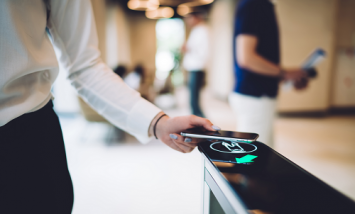The security industry is quickly evolving with the emergence of new technology. As we near the end of 2020, we are seeing new trends that will shape the future of physical security. By identifying access control trends for 2021, facility managers can properly prepare to meet both business and end user needs.
Mobile Access Control
More than 93% of Americans own a smartphone, and they can now be used to do just about anything. So, it only makes sense that mobile credentials will play a leading role in the future of physical access control technologies.
Key card access control systems are quickly becoming obsolete. Cards are often lost or misplaced, and can easily be hacked using relatively inexpensive equipment. Mobile credentials offer a more secure and convenient solution. Since people tend to bring their mobile phones with them everywhere, these devices have organically evolved for the access control industry.
Additionally, mobile access control offers remote capabilities. For instance, a tenant can grant access to a visitor from a mobile app on their phone once being alerted through an apartment intercom system. This can be done from anywhere – as long as the tenant has their mobile phone.
Adoption of the Cloud
Traditional access control systems are expensive, requiring servers, wiring, and annual software licensing. This limited the adoption of access solutions to larger corporations with the bandwidth to implement and manage these on-premise systems. By using the cloud, secure access is available to any operation.
Cloud-based access control is intuitive to use and offers the most flexibility for administrators. Access credentials can easily be granted or revoked from any device or location. User authorization, access points and data trends are centralized in a single database that is remotely accessible. This is an important advancement in the physical security industry as it eliminates the need of an on-site IT professional to manage the system. Another key benefit that has helped fuel the growing popularity of cloud access control is scalability. Facility and property managers who manage security at multiple sites can easily manage their databases from one location.
Multi-Factor Authentication
As security threats have increased, so has the need for a more secure method to authenticate users. Multi-factor authentication requires the authorization of more than one credential to gain access. For instance, an employee may be required to use their mobile credentials as well as key in a pin before they are allowed to access a facility. Other credentials that can be combined include video intercom, fingerprint ID, mobile credentials, SMS text or email pin. Multi-factor authentication has been taking root over the last few years, and is expected to become even more common in 2021 and beyond. This technology was traditionally required in critical infrastructure and utility industries such as oil, gas, and power plants. However, the emergency of multi-purpose access control readers that support several credentials at once has made multi-factor authentication accessible to every industry.
Biometric Technology
As the demand for touchless access control solutions increases, facial recognition is quickly growing in popularity. Millions of users already use Face ID on their smartphones, and this trend is spreading to other sectors of the security industry. Like using mobile credentials for access control, facial recognition and other biometric characteristics are more secure than legacy access control systems. Moreover, COVID-19 has reinforced the need for touchless technology to eliminate common touch surfaces that can spread disease. Facial recognition access control meets that need and does so in a secure fashion.
Subscription-Based Model
Legacy access control systems operate as a one-time hardware sales model, which requires an up-front investment but also regular maintenance and updates. The growing popularity of cloud-based access control has seen this approach replaced by a subscription-based model. In subscription-based access control models, the up-front cost is much less and a charge per-user is fixed each month. The software is hosted in the cloud and managed by a third party provider, so it’s not necessary to schedule updates and maintenance. Because it gives users the flexibility and control they want, we will see this model becoming more standard in 2021.
Conclusion
Flexibility, safety, and convenience will continue to influence security and access trends into the future. Technologies that are aligned with these trends will grow in popularity and soon become the new standard. More so, access control technologies – and technology in general – that prioritizes user health and wellness will prevail as the industry standard. Becoming familiar with these trends and implementing them will ensure business resilience and end user satisfaction.
| Bethwel Njore is a marketing and copywriting professional who has worked with startups across the board. As a Copywriter at Swiftlane, Njore works to provide credible information to users in the form of case studies, industry-specific whitepapers, and blog posts. |

